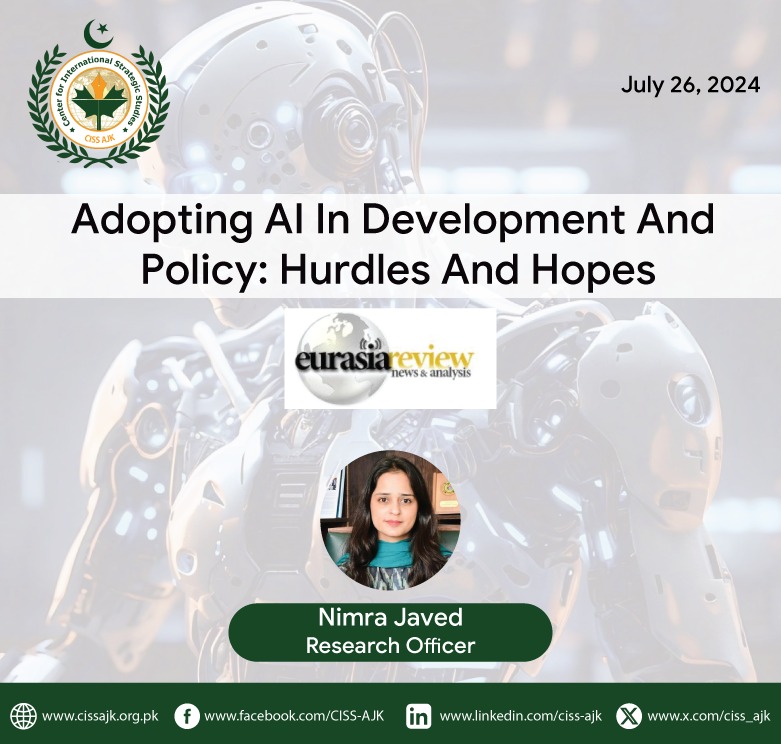The development projects and policy initiatives around the world have been transformed largely with artificial intelligence. So, what AI does is that it can analyze huge amount of data, recognize patterns and may predict future trends in whatever aspect of life.
AI can be used by governments to make better decisions and advance their sustainable development goals. Nevertheless, there will be loads of obstacles in integrating AI into development projects and policy frameworks.
AI in Development and Public Policy
Public policy is reimagined through AI. AI has the potential to fundamentally change decision-making, being able to predict future scenarios more accurately than was possible with just historical data and expert opinion. Lawmakers could for instance use AI-driven algorithms to predict demographic shifts over a decade and help plan social services or infrastructure accordingly.
Furthermore, AI makes it possible to automate the more routine tasks and liberate human resources for meaningful strategic objectives or creative problem-solving. This change improves both operational efficiency and the potential for actual new ways to address old social problems as well. AI reveals data patterns that governments can use to pro-actively develop and implement adequate solutions to new threats before they arise.
These direct AI-driven insights can enable massive economic benefits by steering real-time policy changes and better resource allocations. Governments can use AI to design immediate needs-specific policies while ensuring the flexibility to be adapted in anticipation of future dynamics, thus establishing a more resilient and inclusive economy.
Navigating the Hurdles
The incorporation of AI into development projects and policy initiatives represents a quantum leap for the globe. AI can assess thousands of data points, identify unique patterns, and even predict future trends in every area of human life. Governments may use AI to improve the decision-making process, resulting in enhanced human development and more sustainable development.
Clearly, there will be numerous challenges at the same time as AI is applied to development projects and policy frameworks. Although there is much ground breaking potential in the incorporation of AI in public policies and development, there are still numerous barriers to consider. For example, demanding that the data be of high quality and highly reliable is one of them.
Currently, AI algorithms only function as well as the data available to them. Uneven information gathering as well as a multiplicity of sources of data stymie the accuracy and dependability of AI throughout the globe. A powerful digital foundation, such as a secure internet and a place to keep sensitive data, is necessary for the use of artificial intelligence to be effective.
AI insights and adoption may be impeded by regional disparities in service offerings. A staff well-versed in data analysis, AI programming, and policy interpretation should also be available to effectively make use of AI technology. Extensive training initiatives need to be funded by governments to help government workers and lawmakers to be able to use AI to the fullest.
Organizational non-acceptance flat negative resistance to innovation or old techniques. This kind of technical agility is the antithesis to organizational inertia that fights AI-based methods. Also, it depends on the area from type of digitisation and also the amount involving knowledge in addition to this number determines how much you can get AI use-cases run. If disparities in local literacy rates and technical literacy may already exacerbate inequities by lack of access to services, opportunities etc. resulting from AI-generated production, what will be the impact of more-inified ways via AI.
Towards an AI-Powered Future
Maintaining synergy between governments, industries and universities is key to these challenges being met successfully. Policymakers can help by making investments in data infrastructure and education, while ensuring that areas like the arts are included alongside science subjects for a more interdisciplinary approach to problem-solving. Solutions may be better addressed through collaborative efforts that foster knowledge sharing and capacity building, harnessing the revolutionary power of AI while mitigating its dangers.
Navigating the complexity of integrating AI into development and policy frameworks requires a strong commitment to inclusive and ethical AI principles. Responsible and equitable AI use by governments has the potential to promote sustainable development, create fair growth opportunities for everyone and improve quality of life.
For countries with lower technological development levels, this sole action presents significant challenges. Digital infrastructure is poor; specialists are in short supply, budgets limited, there is a natural resistance to move away from paper-based systems and the gaps go on – sustaining inequity. Our investments in digital infrastructure should be a top priority, along with training and future education so that we can develop the necessary capacity among our workers – supported by an environment of local innovation ecosystem support, adapting institutions to convey (legislative), plus inclusive development policies phase.
To harness AI’s full potential and close the technological gap with more advanced countries, countries must learn to collaborate on AI in ways that respect core human values while ensuring sustainable development for all their citizens. Ensuring that AI benefits all cultures regardless of their current technical conditions will require cooperation and global partnerships.
Overall, AI has the potential to provide solutions that could lead to better developmental and public policy outcomes but there will be numerous hurdles on the way. Addressing them head-on and not waiting to plan for the future is how one can make AI a meaningful force of good on this planet.
Nimra Javed
Nimra Javed is a Research Fellow at CISS AJK.



